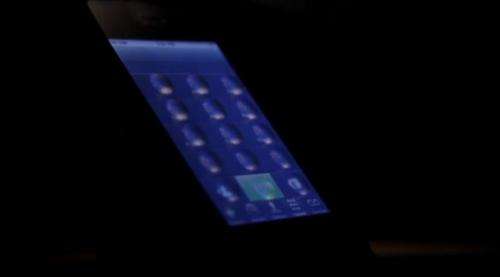June 6, 2012 report
Tactus shows tablet keyboard rising from flat screen (w/ Video)

(Phys.org) -- Why settle for flat? That is the question highlighted on the home page of Tactus Technology, which does not want device users to settle for any of today’s tactile limitations on flatscreen devices. The Fremont, California-based company has figured out how to put physical buttons on a display when we want them and no buttons when we don’t. Tactus has announced its tactile user interface for touchscreen devices that are real, physical buttons that can rise up from the touchscreen surface on demand.
The on-demand feature is noteworthy; with the buttons enabled, users are free to push the keys and type; when buttons are disabled, they recede into the screen and become invisible.
Tactus made the announcement earlier this week at the Society for Information Display (SID) Display Week 2012 in Boston where its "Tactile Layer" panel was shown on a prototype Android tablet. The company’s patent-pending technology is to be ready for use in commercial devices by mid-2013.
The customizable buttons can appear in a range of shapes and configurations. Buttons may run across the display, or in another collection of round buttons to represent a gamepad for playing games. “We are a user interface technology where people can take our technology and create whatever kind of interface they want," said Nate Saaal, VP business development. He said it could be any shape or construct on the surface.
Whether the flat-screen interface belongs to a smartphone, tablet, or gaming device, the company says power consumption is minimal.
Outside the company, researchers into tactile technologies agree that, as attractive as tablet devices are for media consumption, knowledge workers depending on traditional desktops and laptops have held back from using them more fully because of touchscreen typing, prone to typos and in turn slowing down the user’s typing speed. Tactile button options for gamers is also seen as a plus, as a user ideally needs to keep eyes on the screen, and be able to push the right game buttons at any moment.
If the concept sounds vaguely familiar, it should. The idea for this type of touchscreen surface came to Craig Ciesla, CEO of Tactus, in 2007, when he chose to use his BlackBerry instead of a newly released iPhone because of the former’s keyboard. He began to think about the possibility of adding a physical tactile surface option to flat touchscreens. Whether keyboard or other interface, the tactile buttons might rise and fall out of a touchscreen on-demand. He said the answer to that lay in microfluidics, the manipulation of fluids, geometrically constrained to a small, typically submillimeter scale.
Microfluidic technology underlies the interface technology. When triggered, a thin layer deforms and buttons or shapes of a specific height, size and firmness appear on the surface of the screen. Users can feel, press down and interact with the buttons as on a keyboard. The company's design calls for a thin transparent cover layer with special properties laid on top of a touchscreen display. Made of glass or plastic, the layer has microchannels filled with a nontoxic fluid. Increasing fluid pressure with a small internal controller causes the transparent physical buttons to grow out of the surface of the layer in less than a second. The company says the technology allows OEMs to “dramatically differentiate” their devices “by providing the best of both touchscreen and keyboard technology.”
The Boston show demo was a result of Tactus partnering with Touch Revolution, a manufacturer of touch displays.
© 2012 Phys.Org




















